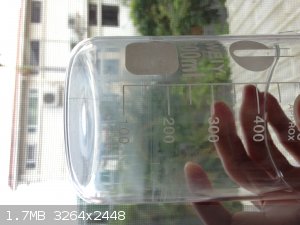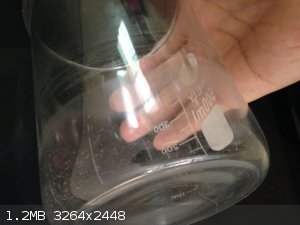
dawsonsuen - 27-7-2015 at 00:10
Does anybody knows how to remove this beaker stain..?
I have tried cleaning the beaker with oxalic acid, concentrated hydrochloric acid, hot concentrated sulfuric acid, saturated sodium hydroxide, citric
acid, acetic acid and a 6% sodium hypochlorite solution...
I've also tried using several organic solvents and it didn't work...
Can anyone who knows a way to deal with this tenacious stain please reply..
Thank you.


Volanschemia - 27-7-2015 at 00:28
Do you know what the stain is? That will help people work out what would be best to remove it.
Piranha solution (1:1w/w Sulphuric Acid:Hydrogen Peroxide. Be careful working with it though.) works very well for removing organic stains. Ethanol
and a little bit of Nitric Acid works well also (beware lots of NO2 will be evolved).
[Edited on 27-7-2015 by TheAustralianScientist]
dawsonsuen - 27-7-2015 at 00:45
I'm not sure what the stain is, my guess is that it would be some sort of water stain...
It might also be sodium acetate or zinc sulfate, but I believe that's highly unlikely due to their high solubility in water...
My last use of the beaker was to react zinc metal with dilute sulfuric acid to produce zinc sulfate.
But shouldn't water stains like calcium carbonate react with the acid I used and dissolve away anyway?
Sulaiman - 27-7-2015 at 00:53
I have used a kitchen stainless steel scouring pad to remove some stubborn stains,
use washing detergent and water to minimise scratching of the glass.
Do not use normal wire wool as it scratches the glass too much.
kecskesajt - 27-7-2015 at 01:12
What if the stain is outside?You cooled the beaker in an icebath and it started to form limescale(or how do you call it).
dawsonsuen - 27-7-2015 at 01:14
I've even tried gently sanding the stain off with sand paper but it didn't work, none of the stain came off.
dawsonsuen - 27-7-2015 at 01:16
I'm pretty sure the stain is inside because I could feel it when I touch it
MrHomeScientist - 27-7-2015 at 05:26
If you can feel something, it's possible the glass is etched and it's not actually a stain. You might want to just leave it. If it survived untouched
after all the intense chemical treatments you put it through, then it's unlikely it'll interfere with any normal chemistry!
Varmint - 27-7-2015 at 08:00
I've run into something similar. I used large heavy wall beakers for my MMO/Titanium Chlorate cells (I machine the tops from large PVC blanks).
Anyway, I thought for sure it was an etch because it was so chemically inert. I tried all the suggestions, but the only thing that removes it is
BonAmi cleanser, or Bar Keepers Friend. A barely moistened paper towel sprinkled with either cleanser begins to get after it after vigorous
scrubbing, occasionally re-moistening the towel and adding a bit more cleanser.
When clean, the beaker wall is shiny/smooth as if shipped from the factory, so I know it's not an etch being polished out. It seems to slough off in
tiny patches, if it were simply being polished out there would be a noticeable transition from the starting state, to less and less cloudy, but again,
at some point it just releases in small patches.
Surely there is something that can attack it chemically, I know I don't have whatever that might be...
Warm (not hot) concentrated NaOH solution seems to soften it ever so slightly, but I didn't want to end up etching, so I use the pure mechanical
removal.
[Edited on 27-7-2015 by Varmint]
macckone - 27-7-2015 at 08:15
The first chemical on the list is oxalic acid. Lots of metals form very insoluble substances with oxalic acid. That is the last chemical you want to
use. My guess is that you now have oxalates on the glass 
Sulaiman - 27-7-2015 at 09:43
Barkeeper's Friend is oxalic acid and citric acid. http://www.uline.com/PDF/MS-20096.pdf
so I guess it depends upon which metal/cation whether it cleans, or stains !
The Volatile Chemist - 27-7-2015 at 12:19
I used a whole bunch of laquor thinner today at my job to clean off spray-gun paint containers, and got to use a sweet $30 Disposable Respirator 
Boffis - 27-7-2015 at 15:26
Are you sure they are stains and not scratches? I find that the persisitent use of glass stirring rods without a pipette teat on the end causes tiny
white impact scars that can't be removed. I initially thought they were stains and tried the same sorts of things to remove them until I examined a
broken beaker fragment under the microscope and all was revealed.
In any cause if you can't remove then they are unlikely to contaminate future reaction.
dawsonsuen - 27-7-2015 at 21:02
Thank you for the reply everyone  ,,
,,
Again, I'm pretty sure that the stains are not scratches because I could feel some tiny tiny lumps on the wall of the beaker and yet they are so
tenacious that they couldn't be removed by sand paper.
Also, I understand that there are glass scratches in the beaker, but there are also white circular stains of which I was trying to remove.
Thank you all again for sharing past experiences. 
P.S: To be honest, I'm aware that the stains will not contaminate my future reactions, but I just didn't want to be defeated by some beaker stains...
[Edited on 28-7-2015 by dawsonsuen]
ahill - 28-7-2015 at 17:28
I use 28% hardware grade HCl and 3% H2O2 on the stains that have beaten everything else.
Very cheap, and very effective.
Once I needed to alternate washing with this, then with bleach, but otherwise, its never been beaten.
Probably would'nt want to get it in your eyes.
diddi - 28-7-2015 at 17:48
"tiny lumps" = have you been making silicates? they are like that... very hard to remove



 ,,
,,
